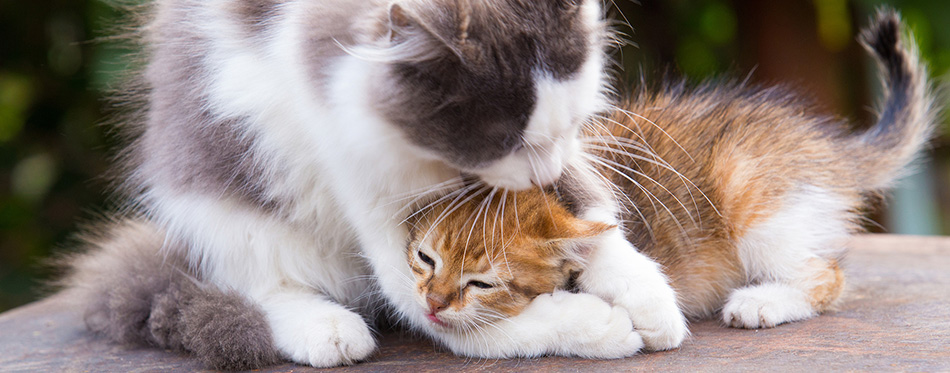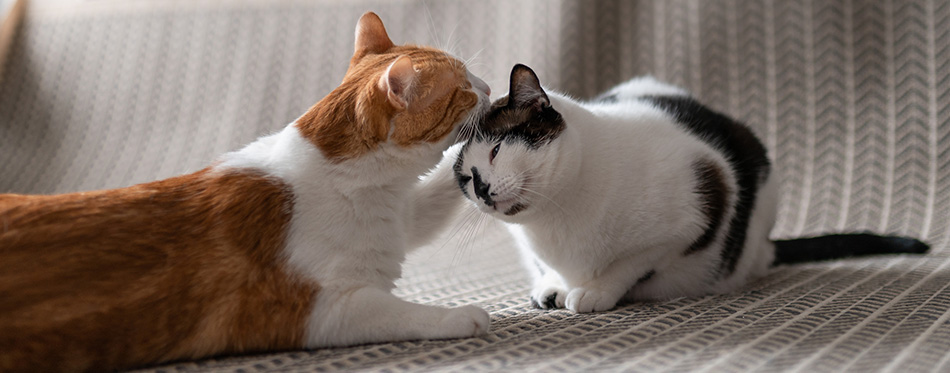If you live in a multi-cat household, chances are you’ve seen some puzzling behavior. Cats tend to exhibit behavior that clearly shows whose part of their circle and who’s not. One ordinary behavior often seen in multi-cat households is grooming. Many people don’t realize that the term grooming essentially refers to a single cat grooming themselves. Allogrooming is the scientific term used when one or more cats groom each other, and there are several different reasons why cats groom one another.
Grooming in cats is interesting because even cats who don’t get along often take part in a certain form of grooming. However, cats who are siblings, friends, or even mates are known to groom each other more often and are known for spending hours at a time licking their fuzzy pals. When it comes to grooming, specific patterns are often seen. For example, one cat may groom another more often, another one not at all and the last cat to show them their leadership. The act of grooming isn’t as simple as it may seem, and this article we’ll discuss the many reasons cats groom one another and many of them will shock you.

Are They Just Cleaning Each Other?
Self-grooming is an obvious form of hygienic behavior and cats are very hygienic animals. If you’re a cat owner, you’ve likely witnessed your cat sit and groom themselves for hours. They are big fans of maintaining their hygiene through a healthy coat, even going as far as to bite off knots and other discrepancies they find throughout their fur. Typically, self-grooming is done on a daily basis to maintain their clean and healthy coat, although some cats are known to self-groom less often than the norm, occasionally skipping a day.
Grooming for hygienic reasons remains the most common reason why cats groom each other. It’s said that cats appreciate the help of their feline friends when they assist with their washing and grooming routine. The act of social grooming starts at birth. When the mother first gives birth to her kittens, she will immediately take the time to clean each and every kitten until they are sparkling new. Subsequently, you’ll frequently find the kittens cleaning one another or even giving their mother a bath.
The main reason cats groom each other for hygienic purposes is because cats simply can’t reach all areas that need cleaning. While licking their paws and utilizing them to clean certain areas they can reach can be effective to a point, a sympathetic feline friend can reach all those hard to reach areas like the head and the neck, assisting their friend in maintaining a shiny clean coat. Self-grooming and social grooming are especially effective for hygiene because of their unique tongue. Their sandpaper-like tongues and pointed teeth make it easy to untangle matted fur, comb away stray hairs, and even remove dust particles from deep down inside the fur.
Grooming for Social Boding
When we think of the cat, we often think of a lazy sleeper, who enjoys spending most of his time alone. However, according to a 2004 study by the Journal of Feline Medicine, which examined cats’ social behavior, while they are long thought to be solitary, independent creatures, the results determined that under the right circumstances, cats actually prefer to be social with other domestic cats and like to hang out in groups.
Similar to a feral colony of cats outdoors, when there is a central food source, the cats will join together and create a united front. However, when food is scarce, they will spread out and keep to themselves. When several domesticated cats are kept together in a home, the process is similar to that of the feral group. The cats kept in the home develop social relationships with one other, which thrive mostly when they are in a happy environment with their needs met. These relationships include hierarchies, and the cats may not always get along but they certainly recognize one another as individuals and establish a ranking system, or what’s referred to as a ranking order.
According to the same study, cats choose certain companions who they prefer over others. For example, a cat living in a household with five other felines will typically favor one other cat and they will actively seek out that cat to groom. Likewise, if the cat would like to be groomed by his preferred companion, he will approach his mate and flex his neck, encouraging his mate to groom him. Even if one of them are not actively seeking the grooming session, the cats who are friendly towards one another will cooperate and allow the grooming to take place as a bonding session.
When grooming is done as part of social bonding, the cat being groomed displays certain behavior that signals their enjoyment to their furry friend. One example of the cat showing enjoyment during the grooming session is moving their head and chin, allowing their companion further access to the areas in need of grooming. They’ll display reactions of enjoyment while being groomed, like purring and kneading their paws. Cats who are grooming to bond will also display friendly signals, like holding their tail vertical to the ground, rubbing their tail against the groomers tail, and at times they even curl their tails together as a sign of total bliss. While grooming, for this reason, many times, the cats will each take the turn as the groomer and the received, but this isn’t always the case. According to experts grooming one another as a form of bonding is done because it reinforces social bonds between members of their “pride.”
Aggressive Grooming for Dominance
It’s almost shocking to most people when they find out that certain grooming sessions are actually an act of aggression, as the alpha cat is reminding those lower on the totem pole that they are the dominant feline. Even if the cats seem happy and relaxed, they can still be partaking in aggressive grooming. While it’s difficult to tell which type of grooming session is taking place, paying attention to your cat’s demeanor, such as his ears down or tail between his legs, will help you determine if it’s an act of bonding, cleaning, or your cat showing their dominance in the pack.
Aggressive grooming in unique in that isn’t actually aimed towards hurting the receiver, but basically, to remind them of whose boss. The cat that is socially higher ranking and displays a lot of confidence will be the one doing most of the grooming around the house. They tend to often groom the least dominant and less confident cat. While this isn’t always the case, it’s known by experts that if one cat is the victim to another cat, that cat will generally receive more grooming and licking from the aggressor cat due to the dominance factor taking place. In some cases, you may even see the dominant cat forcing the grooming on the less dominant cat by holding them in place, or gently biting the back of their neck when they try and get away. Aggressive grooming is more common in households with multiple cats. However, there is almost always only one aggressive groomer and there may be several cats who receive the grooming as the head cat reminds the pack of his ruling.

Grooming for Affection
While grooming as a form of bonding is somewhat similar, it varies in many ways from an affectionate grooming session. Affectionate grooming is common to partners but can occur among any cats who have a close relationship. When thinking of affection grooming, think of it as a sort of kissing. This type of grooming session isn’t about hygiene, strengthening their bond, or showing dominance, but is basically a way of showing their feline companion how pleased they are with each other’s company.
During affection grooming, rather than one cat grooming the other, both cats generally groom each other at once. They will lick different areas than normal like the face and the ears and are also exchanging scent during the session. Scent is everything to cats, if you’ve ever had your cat come up and bump his head against yours, he’s essentially marking you with his scent and claiming you as his own. Affectionate grooming sessions are also good for your cat’s health and well-being, during this form of grooming, they’re offering each other a sense of protection, comfort, and calmness.
Conclusion
While there are many reasons why cats groom each other and different ways of doing it, social and affection-based grooming has been shown to offer much more than just physical benefits. In fact, researchers found a large correlation between the brains releases of oxytocin during social and affectionate grooming sessions. Oxytocin is known as the feel-good chemical. It promotes prosocial behaviors because of the positive emotional response received when it’s released.
Even better, social grooming has also been found to release beta-endorphins. Beta-endorphins relieve stress, lower blood pressure, and can even help strengthen your cat’s immune system while extending their lifespan. Who knew that such a simple act of cats grooming each other could have so many different meanings, not to mention the many positive effects on your cats emotionally and physical well being.
Source:
- Why Do Cats Groom Each Other? – Fuzzy Rescue

